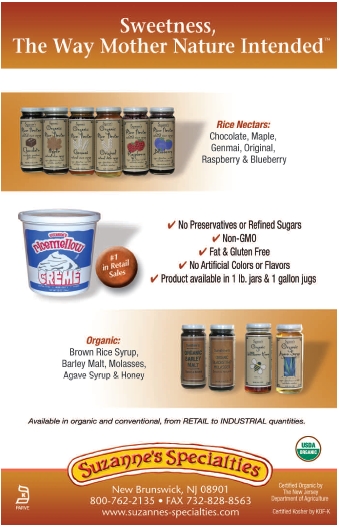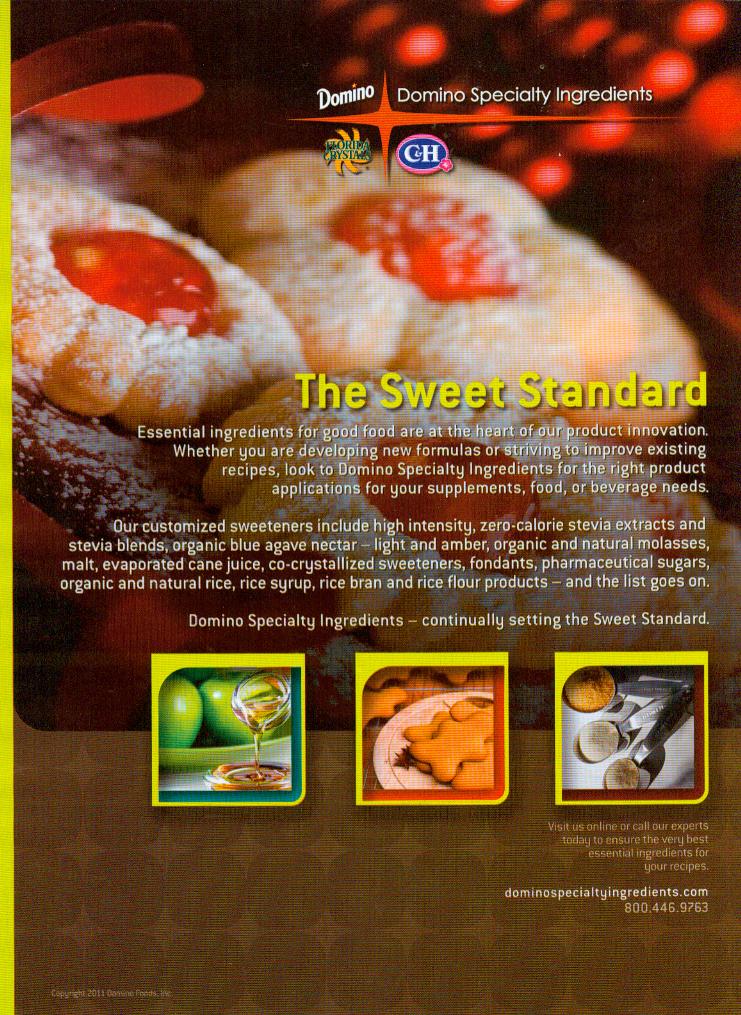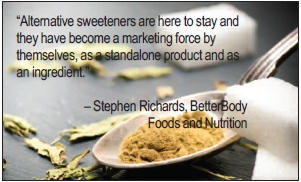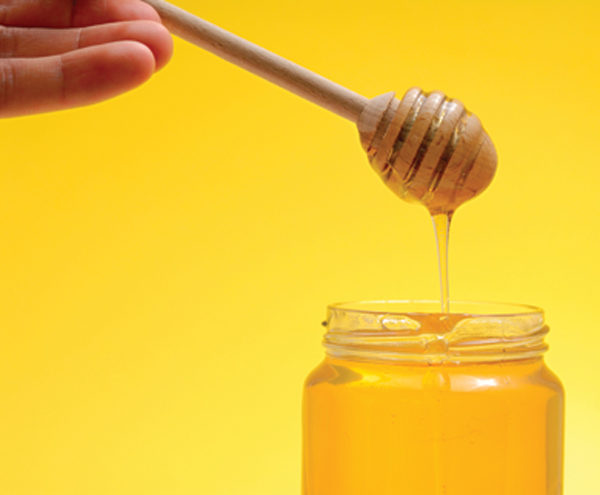It is an exciting time to be involved with the sweetening of our foods and beverages. Chief among the factors driving change is the movement toward healthier foods, which for many consumers starts with how they ate sweetened. Manufacturers big and small are taking notice, and leveraging their changes in an effort to grab consumer attention. Food and commodity prices are other influencers, affecting product formulation across the manufacturing industry.
All of this activity is raising the profile of a variety of non-sugar, “alternative” sweeteners. “However, more alternative sweetener choices will eventually raise the question, ‘Alternative to what?’ Traditionally, it meant alternative to sugar,” says James May, president and CEO of Wisdom Natural Brands, Gilbert, AZ, makers of SweetLeaf Stevia. As they gain market share, other options may approach an equal footing with the likes of sugar and high-fructose corn syrup (HFCS). One estimation puts the size of the global non-sugar sweeteners market at $9.3 billion in 2011, and at a projected $9.9 billion by 2016 (1).
In what follows, purveyors of sweetness will address the industry’s pressing questions and obstacles.
Taste Profiles
Unfamiliar sweetener names on product labels have to gain a measure of recognition and acceptance before they can hit it big, and to do so, they must appeal to consumer tastes . “One of the challenges for industry in adopting low-calorie and natural sugar alternatives is the significant work involved in reformulating its products,” says Markus Lipp, Ph.D., director of food standards for the U.S. Pharmacopeia.
. “One of the challenges for industry in adopting low-calorie and natural sugar alternatives is the significant work involved in reformulating its products,” says Markus Lipp, Ph.D., director of food standards for the U.S. Pharmacopeia.
Individual ingredients have faced individual challenges, beginning with stevia. The rebaudioside A fraction of stevia, in particular, has been known for a citrusy flavor, Lipp says, making it a natural complement for fruit juices, but more of a challenge to incorporate well into soft drink applications. This extra work has resulted in a diversification of the final taste profile of products currently on the market. “Not all stevia products taste the same. Retailers may benefit from giving their customers the opportunity to sample several different brands to find the one they like,” says Neil Levin, education manager for NOW Foods, Bloomingdale, IL.
One major step toward rounding out the taste of some stevia products has been the application of an enzymatic process to curtail a lingering, bitter taste, according to Pauline McKee, vice president of Wholesome Sweeteners, Sugar Land, TX. The process is applied once the stevia fraction or whole leaf stevia has been readied by the manufacturer. ‘The resulting extract is treated with a vegetarian-source enzyme (glucosyl transferase) to reduce the licorice-like bitter aftertaste of other stevia extracts,” says Levin. This has played a part in allowing stevia to make strides where it had been limited before, including with home baking applications.
Another element pertaining to taste is the extraction method. May says his company’s stevia brand uses a water-based filtration method as well as a glycoside extraction method to separate out the sweet elements of the stevia plant’s leaves. Chemical extraction is often used in this context, but the less it is used, the better the final taste p rofile could turn out. “The fewer number of chemicals used also allows the naturally sweet taste of the leaf to be realized,” May says.
rofile could turn out. “The fewer number of chemicals used also allows the naturally sweet taste of the leaf to be realized,” May says.
Often, manufacturers use masking agents to hide the undesirable elements of a sweetener’s taste, specifically the bitter aftertaste in the case of stevia. But, the trend in stevia is to progress beyond this way of doing things, according to May. This prediction for the development of the stevia market also divulges a trend line for alternative sweeteners in general. “As manufacturers develop methods of extraction and separation that require fewer chemicals—and finally none at all—the taste profiles of their final products will be significantly enhanced. It is only a matter of time,” he says.
Stevia qualifies as a high-intensity sweetener, with many sources touting it as hundreds of times sweeter than table sugar. Part and parcel of this quality, though, are the taste challenges being described. “All of these high-intensity sweeteners share one concern or one difficulty, that they all have either a delayed sweetness, or they have a lingering aftertaste,” says Jim Morano, Ph.D., technical affiliate of Suzanne’s Specialties, New Brunswick, NJ. Achieving functionality by leaping over these taste hurdles and other product formulation issues like stability is critical, according to Morano. If this functionality can be achieved, there is the potential for a sweetener to do well in both the natural food and mainstream markets.
Naturally occurring sweeteners (such as honey, molasses and malt extract) can often benefit from the addition of high-intensity sweeteners when formulating products, Morano says. A blend of the taste properties of these natural sweeteners with a high-intensity sweetener like stevia or luo han guo can make for an effective combination. In practice, “We would pick situations where we could use high-intensity sweeteners to subsidize the sweetness of our natural sweeteners,”  Morano says of his company’s business. He gives the example of complimenting brown rice syrup with a high-intensity sweetener in a given product.
Morano says of his company’s business. He gives the example of complimenting brown rice syrup with a high-intensity sweetener in a given product.
Consumers are eagerly waiting for further improvements in taste and adaptability to be made with many of these sweeteners, and industry insiders are on the lookout, too. Says Nathan Jones, CEO of Xlear, Inc., Orem, UT, “I keep looking for a granola or snack bar that tastes great and has below 100 calories. I would love to see some of the snack makers start to make snacks with sweeteners like xylitol, erythritol, stevia and other lower calorie sweeteners.” Jones, whose firm specializes in xylitol, contends that this creativity with sweeteners will become a bigger part of product formulation as time rolls on.
The continued innovation in taste, in finding suitable carrier for the more potent sweeteners, and in the overall stability of these options for various production needs, such as temperature, will be needed for them to progress in the market, according to Lipp. Specifically, issues like freeze–thaw cycles and shelf-stability over long periods of time must be addressed, as up-and-coming sweeteners make a bid for acceptance.
The Health Attraction
The impetus behind all of this change is a combination of the marketing cachet of and the genuine need for “healthier” sweetener options. “Every day, we hear Jay Leno, doctors, dietitians, our parents and many others discussing how the obesity  problem here in the United States is cause for concern. I believe that as long as this continues, the demand for alternative sweeteners will continue to grow; including the demand for natural ones,” says Jones. For one thing, he adds, there is growing recognition that many health problems may be related to the chemicals used in processed food, and people know artificial sweeteners fall into that category.
problem here in the United States is cause for concern. I believe that as long as this continues, the demand for alternative sweeteners will continue to grow; including the demand for natural ones,” says Jones. For one thing, he adds, there is growing recognition that many health problems may be related to the chemicals used in processed food, and people know artificial sweeteners fall into that category.
“Health and benefit issues are what I believe is going to drive the market,” Jones says. He thinks that those looking for a zero-calorie sweetener will end up preferring stevia and/or erythritol. Those seeking a sweetener low on the glycemic index will look to xylitol for that reason, as well as for its oral hygiene benefits. Some sweetener products today also contain inulin, a prebiotic fiber that allows consumers to replace and reduce the fat and oil content of their food, according to Stephen Richards, president and CEO of BetterBody Foods and Nutrition, Lindon, UT, makers of Xagave. “Inulin simply improves the ‘mouth feel’ of foods and enhances the body and texture of baked items which permits you to cut your oil in half,” he says.
The low-caloric, blood sugar-friendly profiles of many natural sweeteners could constitute a major change in public health if they ever become truly dominant in the market. “It is a matter of consumer education at this point. Nutritionists, doctors, governments and food industry leaders will continue to work together to help people understand the impacts of food choices on their health,” says McKee.
Regulating Sweet
The discussion about individual sweeteners and their respective taste and health profiles sets the stage for market talk. All of the sweeteners described, along with mass mar ket options like corn syrup, HFCS and refined sugar, must jockey for similar positions on the consumer’s radar. As manufacturers make the switch in some cases from mass market options like HFCS to other sweeteners, they aren’t hiding the changeover from consumers. Instead, they are promoting the new sweetening agent based upon whatever positive associations a name, like agave honey for instance, has accrued with the public. Morano points out that these types of displays on product labels, not to mention on ingredient labels, serve to distinguish a product in a certain way. “It tells the consumer that a product is formulated as a natural food product,” Morano says.
ket options like corn syrup, HFCS and refined sugar, must jockey for similar positions on the consumer’s radar. As manufacturers make the switch in some cases from mass market options like HFCS to other sweeteners, they aren’t hiding the changeover from consumers. Instead, they are promoting the new sweetening agent based upon whatever positive associations a name, like agave honey for instance, has accrued with the public. Morano points out that these types of displays on product labels, not to mention on ingredient labels, serve to distinguish a product in a certain way. “It tells the consumer that a product is formulated as a natural food product,” Morano says.
Often, though, this is as much about connotation as the health of the product. “Alternative sweeteners are here to stay and they have become a marketing force by themselves, as a standalone product and as an ingredient. As a result, you will be seeing a lot more products on the market that will say ‘Sweetened with Agave’ or ‘Stevia,’” Richards says. But the unfortunate result of this labeling is that many products will continue to utilize HFCS or other sweeteners that consumers may be seeking to avoid, while touting the inclusion of agave or stevia, for instance.
This practice has manifested itself through the repeated use of certain phrases. “Since there is a trend toward blending sweetening ingredients, we’ll probably experience broader messaging such as ‘naturally sweet’ and ‘less sugar,’” says May. This is why Richards thinks consumers should carefully read labels, since some of the low-glycemic and calorie-reducing benefits of alternative sweeteners may be negated in these scenarios.
|
The strictures imposed by government agencies have played a major role in the sweeteners market in recent years. These include the marketing distinction between foods and dietary supplements, and the need to achieve Generally Recognized As Safe (GRAS) status to market a substance as a food. Stevia, in particular, has seen its profile restricted and finally rise with the development of its regulatory status. May notes that regulatory agencies around the world have concurred that stevia is safe as a tabletop sweetener, as well as for use in high-volume, finished product food applications. This is as long as purity meets the standards of the Joint Expert Committee on Food Additives of the World Health Organization.
With this backdrop, May sees it as likely that whole-leaf stevia products, as opposed to some of the GRAS fractions of stevia currently in the food market, will be approved for food marketing in the future. “To not allow stevia leaves to be sold as a food is comparable to determining that spray-dried carrot juice may be consumed but whole carrots cannot be sold as a food. Consumers need to demand the right to add stevia leaves to their normal diet,” he says. Lipp notes that readers with their eye on the trade press will have followed the developments for stevia firsthand, and it’s not over yet. “The regulatory adoption of various forms of stevia is such a dynamic area that any statement would be outdated within days,” he says.
Global standards for various sweeteners are developed as part of the U.S. Pharmacopeia’s Food Chemicals Codex (FCC), a compendium of such standards for food ingredients of all kinds. According to Lipp, specific sweetener standards in the FCC include those for cyclamates, saccharin, sucralose, stevia (rebaudioside A), monk fruit (luo han guo) and more. Lipp calls sweeteners a key focus area for expansion of the FCC.
There can be a significant amount of variation in the quality of natural sweeteners, according to Lipp. “Given that manufacturers and consumers pay a premium for such ingredients, all parties in the supply chain need to be able to verify not just that the ingredient is of the necessary purity, but that it is in fact the ingredient it claims to be, and is not substituted with a cheaper alternative,” he says.
The overall growth potential for the sweetener category is tough to read, with some market segments seeming to grow while others contract, according to Levin, who states, “For example, some traditional sweeteners like maple syrup have lost some sales to newer ones such as agave nectar, which is even showing up as an ingredient on restaurant menus. As with everything, consumers seem to want a variety of options.” He offers the insight that sales look promising for organic agave nectars, erythritol and xylitol right now, and for organic stevia products in particular. “As stevia is approximately 200–300 times sweeter than sugar, very little is needed. This may even save food manufacturers money in the long run once they perfect their recipes,” says McKee.
Meanwhile, growth is limited by the foothold traditional artificial and high-caloric sweeteners have. HFCS may be hard to budge too far aside, if only because it is so entrenched in the way the food industry in the United States is structured. “A s heavily subsidized as it is, I think it will be long time before a cheaper sweetener is brought to market,” says Jones. And the industry behind HFCS is fighting back against the tide of negative press with a massive rebranding effort (see coverage in this issue, page 14). Whatever the future of the sector may hold, it seems certain that a variety of natural options will be giving the old standbys a run for their money. WF
s heavily subsidized as it is, I think it will be long time before a cheaper sweetener is brought to market,” says Jones. And the industry behind HFCS is fighting back against the tide of negative press with a massive rebranding effort (see coverage in this issue, page 14). Whatever the future of the sector may hold, it seems certain that a variety of natural options will be giving the old standbys a run for their money. WF
Reference
1. BCC Research, “Global Markets for Non-Sugar Sweeteners,” www.bccresearch.com/report/non-sugar-sweeteners-market-fod044a.html, accessed Oct. 27, 2011.
Published in WholeFoods Magazine, December 2011









